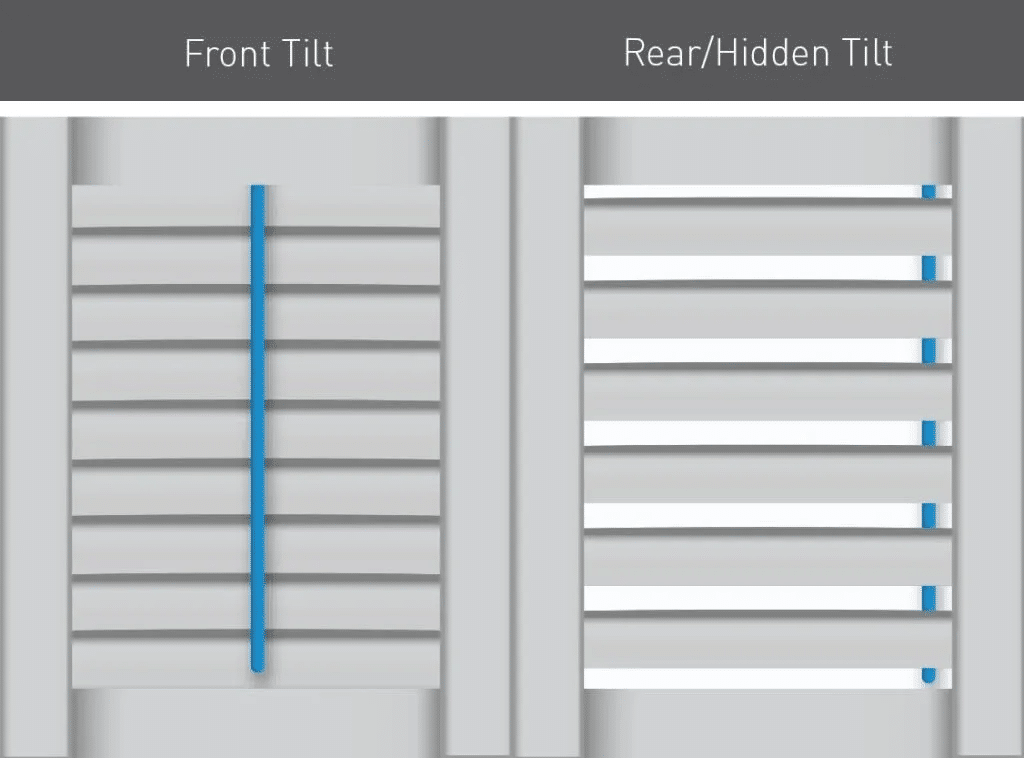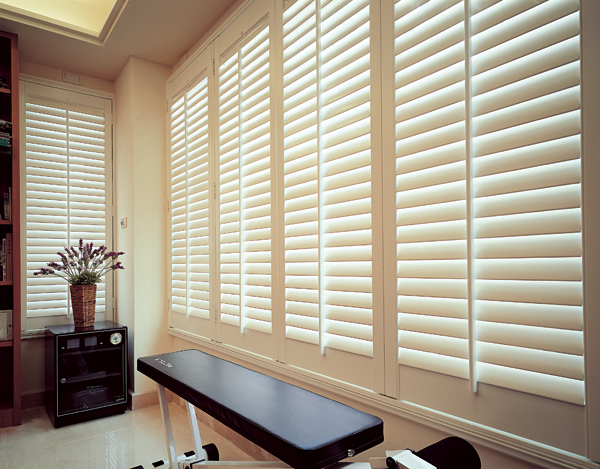Natural wood is an excellent material choice for plantation shutters. It is excellent, holds its value, and is relatively easy to find. If you want to upgrade your home, it would be a great idea to get some new wood plantation shutters.
An important thing to know about window coverings is plantation shutters are the only window treatments that hold their value in full over time.
Vinyl shutters can be great if you are trying to save a little money or if the shutters are in rooms with high moisture.
Some newer homes have a more modern style; with some paint and hidden metal tilt shutters, these window coverings will fit right in!

Vinyl shutters have been trendy for a few years now. Like wood, they can provide much protection from the heat at less cost.
Pros of vinyl plantation shutters:
They can be easily cleaned. Vinyl shutters are an excellent option for high-moisture areas.
Con’s to vinyl shutters:
They are heavy-weight, flexible, not easy to repair, and subject to UV rot and discoloration over the years.
Vinyl shutters are an alternative to wood shutters. They are made from plastic or PVC and are designed to be durable and solid. They do very well in high-moisture areas such as bathrooms and kitchens. Vinyl plantation shutters aren’t the most environmentally or health-conscious options but are a little more affordable. Vinyl shutters can be modified in different finishes to your liking, but vinyl tends to have fewer possibilities than wood shutters.
How to Compare Wood and Vinyl Shutters
Wood Shutters Vs. Vinyl Shutters? Here are some points that you should consider while comparing wood and vinyl shutters:
Colors: Vinyl Plantation shutters are available in a limited range of neutral shades. Vinyl cannot be painted, stained, or refinished.
Wood shutters come in many shapes, finishes, and colors.
Maintenance: Vinyl shutters are the best choice in areas with high moisture. The best shutters in basements, kitchens, and bathrooms are vinyl. No matter the humidity or moisture levels, they will not warp or swell. Wood shutters are much stronger than vinyl shutters but vulnerable to moisture damage.
Strength and Durability: Vinyl shutters are a good option for people who want their windows insulated from heat elements. They can withstand daily wear and tear, temperature fluctuations, and insect infestations. Wood shutters are highly robust and durable. Southern Exposures provides premium-quality shutters with a UV-protected finish that provides durability.
It is essential to pay attention to the material you choose for your plantation shutters. Wood is the way to go if you want to get the most life out of them. Wood shutters will always last the longest as they can be repainted, repaired, and refinished.
We stand behind our wood products 100%, as we feel we flawleffer all of our customers a lifetime warranty on our plantation shutters.
Conclusion
Your decision to choose between wooden shutters and vinyl shutters will depend on your needs, your budget, and your preferences. Vinyl and wood shutters have advantages and disadvantages. It is best to work with a quality manufacturer that offers a long-term guarantee, and you won’t go wrong.
Wood shutters are crafted from natural wood, offering a classic and elegant look, while vinyl shutters are made from synthetic materials, providing durability and affordability. Each option has unique characteristics to consider.
Vinyl shutters are generally more durable than wood shutters, as they are resistant to moisture, humidity, and warping. They are ideal for high-moisture environments such as bathrooms or kitchens.
Yes, wood shutters may require more maintenance, including periodic refinishing or repainting, to maintain their appearance and protect against moisture damage. Vinyl shutters are low-maintenance and easy to clean with soap and water.
Yes, wood shutters are typically more expensive than vinyl shutters due to the cost of natural wood materials and the craftsmanship involved in their production. Vinyl shutters offer a more budget-friendly option.
Wood shutters provide better insulation than vinyl shutters, as wood is a natural insulator that helps regulate indoor temperatures and reduce energy costs. However, vinyl shutters still offer some insulation benefits.
Yes, both wood shutters and vinyl shutters can be customized to match your desired color scheme. Wood shutters can be stained or painted in various colors, while vinyl shutters are available in a wide range of pre-finished colors.
Both wood shutters and vinyl shutters offer excellent light control capabilities. However, wood shutters may provide slightly better light-blocking properties due to the thickness of the material.
Vinyl shutters are more resistant to fading from sunlight compared to wood shutters. Vinyl materials are UV-resistant and do not require repainting or refinishing to maintain their color over time.
While both wood shutters and vinyl shutters can be installed in high-humidity areas, vinyl shutters are better suited for environments with moisture, such as bathrooms, kitchens, or coastal regions, due to their resistance to warping and moisture damage.
Explore our blog for comprehensive articles and guides comparing wood shutters and vinyl shutters, helping you make an informed decision based on your budget, style preferences, and functional needs.

